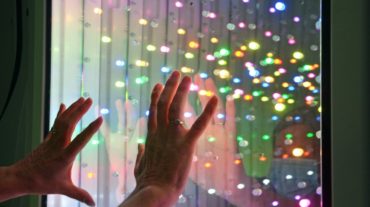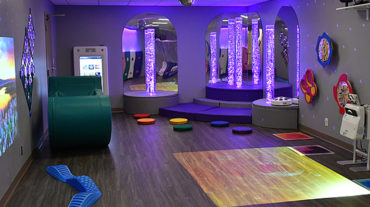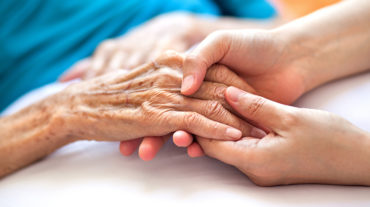Autism
Autism is a lifelong developmental disability that affects how a person communicates with, and relates to, other people. It also affects how they make sense of the world around them. It is a spectrum condition, which means that, while all people with autism share certain difficulties, their condition will affect them in different ways. People with autism may also experience over- or under-sensitivity to sounds, touch, tastes, smells, light or colours.
Asperger’s syndrome
A form of autism, people with Asperger syndrome are often of average or above average intelligence. They have fewer problems with speech but may still have difficulties with understanding and processing language
ASD
Autism is sometimes referred to as “Autisic Spectrum Disorder” (ASD). The word 'spectrum' is used because, while all people with autism share three main areas of difficulty, their condition will affect them in very different ways.
SPD
A person with a Sensory Processing Disorder (SPD) finds it difficult to process and act upon information received through the senses, which creates challenges in performing everyday tasks.
ADHD
Attention deficit hyperactivity disorder (ADHD) is a behavioural disorder characterised by symptoms of inattention and/or impulsivity and hyperactivity.
Dyslexia
Dyslexia is an inherited condition that makes it extremely difficult to read, write, and spell in your native language—despite at least average intelligence.
Dyspraxia
Dyspraxia is an alternative name for Developmental Coordination Disorder (DCD). Dyspraxia mainly causes issues with coordination resulting in clumsy type behaviour. Dyspraxic people also have problems with motor skills
PDD
Stands for Pervasive Developmental Disorders (PDD) and refers to a group of disorders characterized by delays in the development of socialization and communication skills. Other types of PDD include Asperger's Syndrome, Childhood Disintegrative Disorder, and Rett's Syndrome.
HFA
Not an official diagnosis, but can be used to refer to High-Functioning individuals who clearly show Autistic tendencies.
PMLD
People with Profound and Multiple Learning Disabilities, meaning they have more than one disability and are categorised mentally as having an IQ of less than 20. People with PMLD will have:
- A profound learning disability
- Difficulty in communicating
- To receive high levels of support
- Behaviours that challenge us
SLD
Stands for Severe Learning Disabilities and are categorised mentally as having an IQ between 20 and 50.
MLD
Stands for Mild or Moderate Learning Disabilities and are categorised mentally as having an IQ between IQ 50 and 70.
Cerebral palsy
Cerebral palsy is a condition in which impairment to the immature brain affects movement, posture and co-ordination. Cerebral palsy is a wide-ranging condition and can affect people in many different ways. There are three types of cerebral palsy:
- Spastic - Causes the muscles to stiffen and decreases the range of movement in the joints
- Dyskinetic - Difficulty with movement, make involuntary movements, speech can be hard to understand
- Ataxic - Difficulty to balance and have poor spatial awareness
It can be difficult to state what type of cerebral palsy a person has as it is common to have a combination of two or more types.
Snoezelen /
Multi-Sensory Environment (MSE)
- The word SNOEZELEN originates from the Dutch words for Snuffllen (to seek out) & Doezelen (to relax)
- Originated in Holland in the early 80’s as a concept of recreation/relaxation for disabled adults
- Use extended to seniors and children, people with mental illness, chronic pain, autism, ABI and the mainstream population
- Now used in therapy, education, distraction, treatment
- Developed as a distinct environment but also available in portable systems- Cart, SUV, Snoezelen mobile
- Sensory concepts extended into all aspects of life
- Pure’ Snoezelen has no purpose other than enjoyment
- But today, Snoezelen is used increasingly for education, therapy, stimulation, calming, interaction, treatment
- Sessions are best if client led in a safe, comfortable atmosphere with an air of enjoyment, motivation
- Freedom from pressure to achieve
- Client makes choices
- Improved client/caregiver relationship
- An approach designed to enhanced quality of life
Sensory Integration (SI)
The process by which your brain interprets the things you see, feel, smell, hears, taste; and then instructs your body to behave. Sensory Integration treatment is rich in vestibular, proprioceptive, and tactile inputs.
Climbing- is a great way to become aware of your body and its position in space. A child’s weight combined with gravity offers proprioceptive feedback.
Scooters- Flying down the ramp gives kids vestibular stimulation and pulling their body weight up the ramp gives them proprioceptive feedback.
Swings- provide vestibular stimulation in multiple planes, some even spin or bounce. Swings can provide stimulation to help relax or even stimulate the individual depending on the level of input.
Weighted Blankets and Vests- Provide constant, deep pressure input, which helps with calming and organizing
Hypersensitivity/Sensory Overload
Inability to process or manage the amount or intensity of sensory stimuli, frequently observed with autism spectrum disorders, dementia and other mental health challenges such as;
Irritability, anxiety, restlessness
Anger, aggression, violence
Fatigue, sleeplessness
Reduced abilities
Hallucinations, illusions, disorientation
Tension, stress, anxiety, frustration
Coping behaviours
Hyposensitivity/Sensory Deprivation
Inability to process or manage the amount or intensity of sensory stimuli, frequently observed with autism spectrum disorders, dementia and other mental health challenges such as;
Irritability, anxiety, restlessness
Anger, aggression, violence
Fatigue, sleeplessness
Reduced abilities
Hallucinations, illusions, disorientation
Tension, stress, anxiety, frustration
Coping behaviours
Occupational Therapist (OT)
The role of an occupational therapist is to work with a client to help them achieve a fulfilled and satisfied state in life through the use of "purposeful activity or interventions designed to achieve functional outcomes which promote health, prevent injury or disability and which develop, improve, sustain or restore the highest possible level of independence.
Speech & Language Therapist (SLT)
Speech and Language Therapists (SLT) work with parents/carers and others to assess if a child has speech and/or language difficulties, communication or eating and drinking difficulties.
What are the key elements of a Snoezelen Room?
Visual
Bubble Tubes
Fibre Optics
Solar Projectors
Light Chase
Wall Panels
Black Light
Refraction Panels
Tactile
Ball Pools
Cushions/Pillows
Tactile Blankets
Tactile Panels
Carpets
Fan Cushion
Sound
VibroSound
Calming Music
Musical Instruments
Musical Tactile Panel
Smell
Aromatherapy kits
Aroma Dough
Aroma Switch Box
Vestibular
Leaf Chairs
Swings
Rockers
Ball Pools
Proprioception
Puppets
Gloves
Balls
Threading



